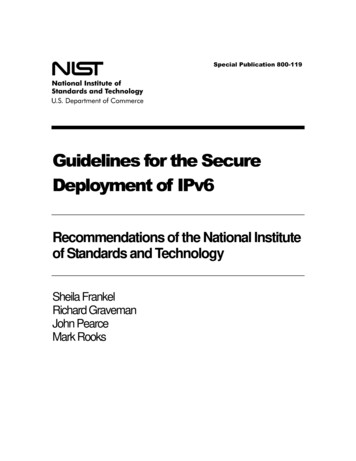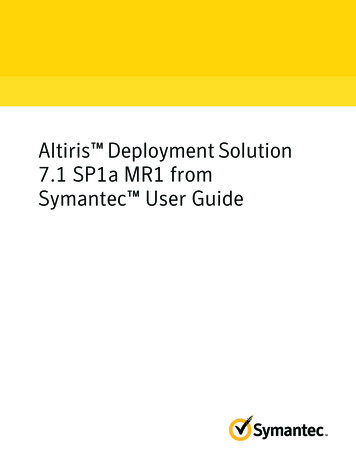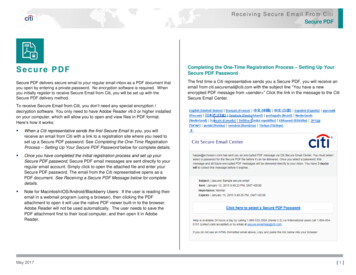
Transcription
Special Publication 800-119Guidelines for the SecureDeployment of IPv6Recommendations of the National Instituteof Standards and TechnologySheila FrankelRichard GravemanJohn PearceMark Rooks
NIST Special Publication 800-119Guidelines for theSecure Deployment of IPv6Recommendations of the NationalInstitute of Standards and TechnologySheila FrankelRichard GravemanJohn PearceMark RooksC O M P U T E RS E C U R I T YComputer Security DivisionInformation Technology LaboratoryNational Institute of Standards and TechnologyGaithersburg, MD 20899-8930December 2010U.S. Department of CommerceGary Locke, SecretaryNational Institute of Standards and TechnologyDr. Patrick D. Gallagher, Director
GUIDELINES FOR THE SECURE DEPLOYMENT OF IPV6Reports on Computer Systems TechnologyThe Information Technology Laboratory (ITL) at the National Institute of Standards and Technology(NIST) promotes the U.S. economy and public welfare by providing technical leadership for the nation’smeasurement and standards infrastructure. ITL develops tests, test methods, reference data, proof ofconcept implementations, and technical analysis to advance the development and productive use ofinformation technology. ITL’s responsibilities include the development of technical, physical,administrative, and management standards and guidelines for the cost-effective security and privacy ofsensitive unclassified information in Federal computer systems. This Special Publication 800-seriesreports on ITL’s research, guidance, and outreach efforts in computer security and its collaborativeactivities with industry, government, and academic organizations.National Institute of Standards and Technology Special Publication 800-119Natl. Inst. Stand. Technol. Spec. Publ. 800-119, 188 pages (Dec. 2010)Certain commercial entities, equipment, or materials may be identified in thisdocument in order to describe an experimental procedure or concept adequately.Such identification is not intended to imply recommendation or endorsement by theNational Institute of Standards and Technology, nor is it intended to imply that theentities, materials, or equipment are necessarily the best available for the purpose.iii
GUIDELINES FOR THE SECURE DEPLOYMENT OF IPV6AcknowledgmentsThe authors, Sheila Frankel of the National Institute of Standards and Technology (NIST), RichardGraveman of RFG Security, John Pearce of Booz Allen Hamilton and Mark Rooks of L-1 IdentitySolutions (formerly of Booz Allen Hamilton) wish to thank their colleagues who reviewed drafts of thisdocument and contributed to its technical content.The authors would like to acknowledge Tim Grance of NIST for his keen and insightful assistance andencouragement throughout the development of the document. The authors particularly want to thankMark Carson, Doug Montgomery and Stephen Nightingale of NIST and Scott Hogg for their carefulreview and valuable contributions to improving the quality of this publication.The authors also appreciate the efforts of those individuals, agencies, and other organizations thatcontributed input during the public comment period, including John Baird, DREN; Alistair de BClarkson, nCipher; Vint Cerf, Google; John Curran, ARIN; Terry Davis, Boeing; Francois Donze andMichael Scott Pontillo, HP; Jeffrey Dunn, Chern Liou, and Jeffrey Finke, Mitre; Fernando Gont, the UKCentre for the Protection of National Infrastructure (UK CPNI); Bob Grillo, US Army; Cecilia Hall, DonRadeke and Joseph Bertrand, USMC; J. Holland, David Leach, Sam Nguyen, M. Roed, Beth Scruggs, D.Wellington and Joe Williams, Aerospace Corp.; Ed Jankiewicz, SRI International; Ralph Kenyon, Caida;Lovell King II, Dept. of State; Joe Klein, IPv6 Security Researcher; Dan Luu, VA; Trung Nguyen, FAA;Carroll Perkins, Serco-NA; and Martin Radford, University of Bristol.iv
GUIDELINES FOR THE SECURE DEPLOYMENT OF IPV6Table of ContentsExecutive Summary . 11.Introduction . 1-11.11.21.31.42.Introduction to IPv6 . 2-12.12.22.32.42.53.Authority .1-1Purpose and Scope .1-1Audience .1-1Document Structure .1-1Early History of IPv6 .2-1Limitations of IPv4 .2-1Major Features of the IPv6 Specification .2-22.3.1 Extended Address Space . 2-32.3.2 Autoconfiguration . 2-32.3.3 Header Structure . 2-32.3.4 Extension Headers . 2-42.3.5 Mandatory Internet Protocol Security (IPsec) Support . 2-42.3.6 Mobility . 2-42.3.7 Quality of Service (QoS). 2-52.3.8 Route Aggregation . 2-52.3.9 Efficient Transmission . 2-5IPv4 and IPv6 Threat Comparison .2-5Motivations for Deploying IPv6 .2-7IPv6 Overview . 3-13.13.23.33.43.53.6IPv6 Addressing .3-23.1.1 Shorthand for Writing IPv6 Addresses . 3-53.1.2 IPv6 Address Space Usage . 3-63.1.3 IPv6 Address Types . 3-73.1.4 IPv6 Address Scope. 3-73.1.5 IPv4 Addressing . 3-93.1.6 IPv4 Classless Inter-Domain Routing (CIDR) Addressing . 3-103.1.7 Comparing IPv6 and IPv4 Addressing . 3-11IPv6 Address Allocations .3-123.2.1 IPv6 Address Assignments . 3-123.2.2 Obtaining Globally Routable IPv6 Address Space . 3-14IPv6 Header Types, Formats, and Fields.3-16IPv6 Extension Headers .3-18Internet Control Message Protocol for IPv6 (ICMPv6) .3-223.5.1 ICMPv6 Specification Overview . 3-223.5.2 Differences between IPv6 and IPv4 ICMP . 3-253.5.3 Neighbor Discovery . 3-263.5.4 Autoconfiguration . 3-283.5.5 Path Maximum Transmission Unit (PMTU) Discovery . 3-293.5.6 Security Ramifications . 3-30IPv6 and Routing .3-343.6.1 Specification Overview . 3-343.6.2 Security for Routing Protocols . 3-35v
GUIDELINES FOR THE SECURE DEPLOYMENT OF IPV63.74.IPv6 Advanced Topics . 4-14.14.24.34.44.54.64.74.85.3.6.3 Unknown Aspects . 3-36IPv6 and the Domain Name System (DNS) .3-363.7.1 DNS Transport Protocol . 3-373.7.2 DNS Specification Overview . 3-373.7.3 Security Impact and Recommendations . 3-39Multihoming .4-14.1.1 Differences between IPv4 and IPv6 Multihoming. 4-14.1.2 Site Multihoming by IPv6 Intermediation (SHIM6) Specification Overview . 4-24.1.3 Security Ramifications for Multihoming . 4-4IPv6 Multicast .4-54.2.1 IPv6 Multicast Specifications . 4-64.2.2 Differences between IPv4 and IPv6 Multicast . 4-84.2.3 Multicast Security Ramifications . 4-94.2.4 Unresolved Aspects of IPv6 Multicast . 4-9IPv6 Quality of Service (QoS) .4-104.3.1 IPv6 QoS Specifications . 4-104.3.2 Differences between IPv4 and IPv6 QoS . 4-114.3.3 Security Ramifications . 4-114.3.4 Unresolved Aspects of IPv6 QoS . 4-12Mobile IPv6 (MIPv6) .4-124.4.1 MIPv6 Specification Overview . 4-124.4.2 Differences from IPv4 Standards . 4-164.4.3 Security Ramifications . 4-164.4.4 Unknown Aspects . 4-26Jumbograms .4-274.5.1 Specification Overview . 4-274.5.2 Security Ramifications . 4-27Address Selection .4-284.6.1 Specification Overview . 4-284.6.2 Differences from IPv4 Standards . 4-304.6.3 Security Ramifications . 4-304.6.4 Unknown Aspects . 4-31Dynamic Host Configuration Protocol (DHCP) for IPv6 .4-314.7.1 Specification Overview . 4-324.7.2 Differences from IPv4 Standards . 4-344.7.3 Security Ramifications . 4-344.7.4 Unknown Aspects . 4-35IPv6 Prefix Renumbering .4-354.8.1 Specification Overview . 4-364.8.2 Differences from IPv4 Standards . 4-384.8.3 Security Ramifications . 4-384.8.4 Unknown Aspects . 4-39IPv6 Security Advanced Topics . 5-15.15.25.3Privacy Addresses.5-1Cryptographically Generated Addresses .5-3IPsec in IPv6 .5-45.3.1 Specification Overview . 5-55.3.2 Differences from IPv4 Standards . 5-8vi
GUIDELINES FOR THE SECURE DEPLOYMENT OF IPV65.46.5.3.3 Support for Multicast . 5-85.3.4 Status of IPsec and On-Going Work. 5-95.3.5 Security Ramifications . 5-155.3.6 Unknown Aspects . 5-16Secure Stateless Address Autoconfiguration and Neighbor Discovery .5-175.4.1 Using IPsec to Secure Autoconfiguration and ND . 5-185.4.2 Using SEND to Secure Autoconfiguration and ND . 5-195.4.3 Current Status and Unknown Aspects . 5-19IPv6 Deployment . 6-16.16.26.36.46.56.66.76.86.9Security Risks .6-16.1.1 Attacker Community . 6-16.1.2 Unauthorized IPv6 Clients . 6-26.1.3 Vulnerabilities in IPv6 . 6-26.1.4 Dual Operations . 6-46.1.5 Perceived Risk . 6-46.1.6 Vendor Support . 6-4Addressing Security .6-56.2.1 Numbering Plan . 6-56.2.2 Hierarchical Addressing to Support Security Segmentation . 6-66.2.3 Problems with EUI-64 Addresses . 6-76.2.4 Address Management . 6-76.2.5 Privacy Extensions . 6-8Transition Mechanisms.6-8Dual Stack IPv4/IPv6 Environments .6-96.4.1 Deployment of a Dual Stack Environment . 6-96.4.2 Addressing in a Dual Stack Environment . 6-106.4.3 Security Implications of a Dual Stack Environment . 6-11Tunneling .6-116.5.1 General Security Considerations for Tunneling . 6-136.5.2 Configured Tunneling . 6-156.5.3 Automatic Tunneling . 6-166.5.4 6over4 Protocol . 6-166.5.5 6to4 and 6rd Protocols . 6-176.5.6 Intra-Site Automatic Tunnel Addressing Protocol (ISATAP) . 6-196.5.7 Teredo Protocol. 6-226.5.8 Tunnel Brokers . 6-276.5.9 Automatic Tunneling of IPv4 over IPv6 (Dual Stack Transition Mechanism[DSTM]) . 6-286.5.10 Carrier-Grade NAT and Dual-Stack Lite . 6-30Translation .6-326.6.1 SIIT . 6-336.6.2 NAT-PT . 6-336.6.3 Replacing NAT-PT . 6-346.6.4 TRT . 6-356.6.5 Application Layer Translation . 6-36Other Transition Mechanisms .6-37The IPv6 Deployment Planning Process for Security .6-37IPv6 Deployment .6-386.9.1 Initiation Phase . 6-396.9.2 Acquisition / Development Phase . 6-41vii
GUIDELINES FOR THE SECURE DEPLOYMENT OF IPV66.9.3 Implementation Phase. 6-446.9.4 Operations / Maintenance Phase . 6-466.9.5 Disposition Phase . 6-466.10 Summary .6-47List of AppendicesAppendix A— Acronyms and Abbreviations . A-1Appendix B— References and Other IPv6 Resources . B-1List of FiguresFigure 2-1. The IPv6 Packet Header Format (Field Sizes in Bits) . 2-4Figure 3-1. IPv6 Address Format . 3-3Figure 3-2. 32-Bit Network Prefix . 3-4Figure 3-3. 48-Bit Network Prefix . 3-4Figure 3-4. 64-Bit Network Prefix . 3-5Figure 3-5. A Comparison of IPv4 and IPv6 Addressing . 3-11Figure 3-6. The IPv6 Packet Header Format (Field Sizes in Bits) (RFC 2460) . 3-16Figure 3-7. Example IPv6 Packet Header . 3-18Figure 3-8. Next Header Fields in IPv6 and Extension Headers . 3-18Figure 3-9. IPv6 Extension Header Chaining . 3-19Figure 3-10. ICMPv6 Message Format. 3-23Figure 3-11. Example of Neighbor Discovery . 3-27Figure 3-12. Example of Stateless Address Autoconfiguration (SLAAC) . 3-29Figure 3-13. Significance of MTU under IPv6 . 3-30Figure 4-1. SHIM6 Protocol Stack . 4-4Figure 4-2. The Main MIPv6 Components . 4-14Figure 4-3. IKEv1 Identifiers used between a MN and its HA . 4-20Figure 4-4. IKEv2 identifiers used between a MN and its HA . 4-20Figure 4-5. Return Routability—Init Messages . 4-22Figure 4-6. Return Routability—Keygen Replies . 4-23Figure 4-7. Reverse Routability—BU and BUA Protected with Kbm . 4-24Figure 5-1. Example of IPv6 Privacy Addressing. 5-2Figure 5-2. Generating Cryptographic Addresses from Public-Private Key Pairs . 5-3viii
GUIDELINES FOR THE SECURE DEPLOYMENT OF IPV6Figure 5-3. IPsec in the TCP/IP Protocol Stack . 5-5Figure 5-4. Encryption and Authentication Algorithms for the IPsec Protocol . 5-9Figure 5-5. Cryptographic Algorithms for Use in IKEv2 . 5-10Figure 6-1. Example of Tunneling IPv6 over IPv4 Networks . 6-12Figure 6-2. IPv6 over IPv4 Tunnels Transparent to the IPv4 Infrastructure . 6-14Figure 6-3. Example - Tunneling IPv6 over IPv4 Networks with ISATAP . 6-21Figure 6-4. Example - Tunneling IPv6 over IPv4 Networks with Teredo . 6-23Figure 6-5. Teredo Address . 6-24List of TablesTable 3-1. Differences between IPv4 and IPv6. 3-1Table 3-2. IPv6 Address Types . 3-6Table 3-3. Assignment of Leftmost, Centermost, and Rightmost Bits . 3-13Table 3-4. IPv6 Extension Headers and Upper Layer Protocols . 3-21Table 3-5. ICMPv6 Error Messages and Code Type . 3-24Table 3-6. ICMPv6 Informational Messages . 3-24Table 3-7. ICMPv6 Recommended Filtering Actions – Must Not Drop & Should Not Drop . 3-33Table 4-1. IPv6 Scoped Multicast Values (from RFC 4291). 4-7ix
GUIDELINES FOR THE SECURE DEPLOYMENT OF IPV6Executive SummaryDue to the exhaustion of IPv4 (Internet Protocol version 4) address space, and the Office of Managementand Budget (OMB)1 mandate that U.S. federal agencies begin to use the IPv6 (Internet Protocol version 6)protocol, NIST undertook the development of a guide to help educate federal agencies about the possiblesecurity risks during their initial IPv6 deployment. This document provides guidelines for organizationsto aid in securely deploying IPv6. Since the majority of organizations will most likely run both IPv6 andIPv4 on their networks for the foreseeable future, this document speaks about the deployment of IPv6rather than the transition to IPv6.2The deployment of IPv6 can lead to new challenges and types of threats facing an organization. The goalsof this document are: To educate the reader about IPv6 features and the security impacts of those features To provide a comprehensive survey of mechanisms that can be used for the deployment of IPv6 To provide a suggested deployment strategy for moving to an IPv6 environmentThe migration to IPv6 services is inevitable as the IPv4 address space is almost exhausted. IPv6 is notbackwards compatible with IPv4, which means organizations will have to change their networkinfrastructure and systems to deploy IPv6. Organizations should begin now to understand the risks ofdeploying IPv6, as well as strategies to mitigate such risks. Detailed planning will enable an organizationto navigate the process smoothly and securely.Federal agencies will most likely face security challenges throughout the deployment process, including: An attacker community that most likely has more experience and comfort with IPv6 than anorganization in the early stages of deployment Difficulty in detecting unknown or unauthorized IPv6 assets on existing IPv4 production networks Added complexity while operating IPv4 and IPv6 in parallel Lack of IPv6 maturity in security products when compared to IPv4 capabilities Proliferation of transition-driven IPv6 (or IPv4) tunnels, which complicate defenses at networkboundaries even if properly authorized, and can completely circumvent those defenses if unauthorized(e.g. host-based tunnels initiated by end users)Organizations planning the deployment of IPv6 should consider the following during the planningprocess: IPv6 is a new protocol that is not backward compatible with IPv4 In most cases IPv4 will still be a component of IT (Information Technology) infrastructure.As such, even after the deployment of IPv6, organizations will require mechanisms for IPv6and IPv4 co-existence.12OMB Memo M-05-22, Transition Planning for Internet Protocol Version 6 (IPv6), August 2005; OMB Memo, Transitionto IPv6, September 2010Since many of the IPv6-related protocols, tools and mechanisms are typically referred to as transition mechanisms, thisdocument does use the word transition in that context.ES-1
GUIDELINES FOR THE SECURE DEPLOYMENT OF IPV6 IPv6 can be deployed just as securely as IPv4, although it should be expected thatvulnerabilities within the protocol, as well as with implementation errors, will lead to an initialincrease in IPv6-based vulnerabilities. As a successor to IPv4, IPv6 does incorporate many ofthe lessons learned by the Internet Engineering Task Force (IETF) for IPv4. IPv6 has already been deployed and is currently in operation in large networks globally.To overcome possible obstacles associated with deploying IPv6, organizations should consider thefollowing recommendations: Encourage staff to increase their knowledge of IPv6 to a level comparable with their currentunderstanding of IPv4 Plan a phased IPv6 deployment utilizing appropriate transition mechanisms to supportbusiness needs; don’t deploy more transition mechanisms than necessary Plan for a long transition period with dual IPv4/IPv6 co-existenceOrganizations that are not yet deploying IPv6 globally should implement the following recommendations: Block all IPv6 traffic, native and tunneled, at the organization's firewall. Both incoming andoutgoing traffic should be blocked. Disable all IPv6-compatible ports, protocols and services on all software and hardware. Begin to acquire familiarity and expertise with IPv6, through laboratory experimentationand/or limited pilot deployments. Make organization web servers, located outside of the organizational firewall, accessible viaIPv6 connections. This will enable IPv6-only users to access the servers and aid theorganization in acquiring familiarity with some aspects of IPv6 deployment.Organizations that are deploying IPv6 should implement the following recommendations to mitigate IPv6threats: Apply an appropriate mix of different
Natl. Inst. Stand. Technol. Spec. Publ. 800-119, 188 pages (Dec. 2010) GUIDELINES FOR THE SECURE DEPLOYMENT OF IPV6 . Doug Montgomery and Stephen Nightingale of NIST and Scott Hogg for their careful . Lovell King II, Dept. of State; Joe Klein, IPv6 Security Researcher; Dan Luu, VA; Trung Nguyen, FAA; .











